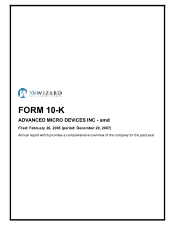AMD 2007 Annual Report Download - page 11
Download and view the complete annual report
Please find page 11 of the 2007 AMD annual report below. You can navigate through the pages in the report by either clicking on the pages listed below, or by using the keyword search tool below to find specific information within the annual report.
Table of Contents
platforms, HyperTransport 3.0 technology, and PCI Express 2.0, a new interface that connects GPUs with the computer system and doubles the bandwidth.
AMD Athlon processors are designed for advanced multitasking on mainstream desktop PCs and are currently available with single or dual-core
technology. AMD Athlon dual-core processors are designed for users who routinely run multiple processor-intensive software applications simultaneously. With
AMD Athlon dual-core processors, computer users are able to perform multiple tasks with uninterrupted performance, and are designed to enable systems to
have the ability to simultaneously download audio files such as MP3s, record to digital media devices, check and write email, edit a digital photo and run
anti-virus scan software.
AMD Sempron processors are designed for everyday computing and provide performance for entry productivity and entertainment software for the
mainstream segment.
Embedded Processor Products
Our products range from low-power x86 architecture-based embedded processors to high-performance, enterprise class, harsh environment-capable x86
architecture-based products. We design embedded connectivity devices to address customer needs in non-PC markets where low power, Internet connectivity
and/or low power processing is a priority. Typically these embedded processors are used in products that require high to moderate levels of performance where
key features include low cost, mobility, low power and small form factor.
Our embedded microprocessor products include the AMD Geode™ product family. AMD Geode microprocessors are 32-bit processors based on the x86
instruction set architecture. These processors integrate functionality such as processing, system logic, graphics, audio and video decompression onto one
integrated device. We also offer embedded processors based on AMD64 technology, which consists of low-power versions of our AMD Athlon, AMD Turion,
AMD Sempron and AMD Opteron families of products. These low power products deliver the same performance as their corresponding full power parts while
offering the added benefit of reduced power consumption and thermal output. These processors are configured specifically for demanding embedded applications
traditionally served by custom silicon designs. We believe these processors also offer our customers the ability to leverage the AMD64 infrastructure. In addition,
a distinguishing characteristic of our AMD64-based embedded processors is our AMD64 Longevity Program. The AMD64 Longevity Program offers a select set
of AMD64 processors with an extended standard availability period of five years. The extended availability period addresses the requirements of customers
designing products for network, storage, blade and telecommunications servers; digital imaging; casino gaming and military and industrial controls systems.
Such markets have lengthy design and qualification cycles and longer life spans in the marketplace than typical mainstream computing products.
In 2007, we also introduced an embedded integrated graphics chipset solution to be used in commercial client applications to address specialized needs
within a variety of industries, including computer devices such as thin clients, single board computers, industrial controllers, digital signage, point of sale
terminals, commercial value clients, and access devices such as gateways and access points.
Our embedded processor products, from AMD Opteron to AMD Geode, exemplify our “x86 Everywhere” microprocessor strategy, which is our goal for
utilizing the x86 instruction set architecture to power a wide variety of devices in diverse places such as the home, office or car, in the supply chain, in storage
networks, in the data center, and/or in global communications networks. We believe that when a greater number of devices are standardized with an x86-based
platform, end-users can benefit from the ability to run their existing x86-based software on devices that interoperate with each other. This can accelerate and
simplify the process of enabling faster, easier connectivity and data sharing between a wide range of products, from portable consumer electronics to PCs and
servers. With our full range of embedded microprocessors, we are able to extend our x86-based product offerings to serve markets from embedded appliances to
embedded server-class products.
6
Source: ADVANCED MICRO DEVIC, 10-K, February 26, 2008
























